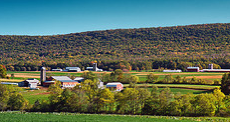By: Amy Davila-Sanchez Bard MBA ’15
As a society, we are approaching crucial times as it pertains to food. The Food and Agriculture Organization of the United Nations projects that by the year 2050, population and economic growth in developing nations will double the demand for food on a global scale. Much of the increase in demand will come from urban cities. According to the United Nations, by the year 2030, five billion people will live exclusively in major cities across the world.
In the United States, rising demand for food is not created equal; demand for processed, mass- produced food is giving way to rising demand for local organic food. According to the United States Organic Food Market Forecast and Opportunities Report, the compound annual growth rate of organics is expected to reach 14% by 2018.
produced food is giving way to rising demand for local organic food. According to the United States Organic Food Market Forecast and Opportunities Report, the compound annual growth rate of organics is expected to reach 14% by 2018.
In light of the growing demand for good food, one would expect that land close to a big urban metropolis like New York City would be conserved for farming operations at a rapid pace. Surprisingly enough, that is not the case for New York City’s closes food shed, the Hudson Valley. Over the last three decades, New York has lost 452,000 acres of land to developers. The Scenic Hudson Food Shed Conservation Plan reveals that of the current 730,000 acres dedicated to farming in the Hudson Valley only 11% are conserved for agricultural practices, leaving 89% of acreage at risk of development to sub division housing or strip malls.
We stand before a new generation of farmers ready and willing to continue in the tradition of farming yet facing a wide array of challenges, the biggest of which are access to land and capital.
Access to Land
New Farmers often find land that is priced many times beyond what they can afford. Form  2000 to 2011 farm values in New York increased from $1,090 an acre to $2,140. In scenic areas like the Hudson Valley, new farmers often compete for land with wealthy city dwellers looking for spacious second homes.
2000 to 2011 farm values in New York increased from $1,090 an acre to $2,140. In scenic areas like the Hudson Valley, new farmers often compete for land with wealthy city dwellers looking for spacious second homes.
Purchasing land is not the only option available for new farmers. Land leases have become more common to this new generation of farmers. Agreements can be made with investors or foundations that purchase land for benefit of conservation easements, then allowing the new farmers to cultivate the land. Currently there is no system in place to match new farmers to land investors. Farmers that operate under this model attribute their lease agreement to good fortune and luck rather than an existent ecosystem that promotes these exchanges.
Access to Capital
Slow Money is a great resource for new farmers looking to finance their sustainable food enterprises. Slow Money’s mission is to save farmland and support a new generation of farmers in reengineering the local food industry. Slow Money’s state of the sector report surveyed individuals and organizations that are actively investing in local food system and sustainable agriculture. From 2009 to 2013, Slow Money tracked a total of 968 deals amounting to $293 million in investments. Year over year the numbers from the study show upwards trends in investment, yet the growth is modest in relations to the demand within the local sustainable food space.
More needs to be accomplished in an effort to bring capital into the sustainable food space. A good example of innovation in the capital raising space for farms is Barnraiser. Barnraiser is a crowd-funding platform focused exclusively on sustainable food ventures. Barnraiser is on a mission to raise one billion dollars through its social funding efforts.
Will access to land and capital be enough to meet the nutrition needs of a growing and health aware population?
What other solutions exist to meet the growing demand for local and organic food?
Learn more in my next blog. In the meantime feel free to share your ideas directly via twitter.